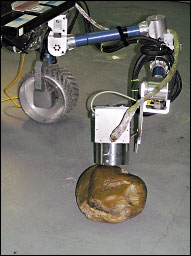
MIA Project Makes NASA Pitch
GOLDEN, Colo., Oct. 18, 2013 — A science instrumentation project called MIA seeks to develop a next-generation in situ geochemical, mineralogical and petrological analysis tool for NASA's PICASSO program.
MIA, or Miniature In-Situ Analyzer, has a range of applications on Earth and in planetary science, said team member N-Science Corp. Other MIA team members include the Space Science Institute, Catholic University of America, Lockheed Martin, Colorado School of Mines, NASA Goddard Space Flight Center and the University of New Mexico.

Leveraging experience gained in previous x-ray instrument development, the MIA team is working toward the next generation of increasingly miniaturized exploration instruments with utility both in space and on Earth. Courtesy of N-Science.
MIA combines x-ray diffraction and x-ray fluorescence with a compact x-ray source and dual CCD detectors. It can address high-priority science objectives such as determining the nature and origin of materials collected in missions to Mars, the moon and near-Earth objects, the MIA team said in its proposal to NASA for PICASSO, Planetary Instrument Concepts for the Advancement of Solar System Observation.
PICASSO is NASA’s project to send landers and rovers to collect samples from planets and near-Earth objects, including asteroids and comets. Such a mission will require rapid, quantitative in situ analysis of unexplored surfaces and/or of potential samples prior to collection, but in an instrument with low mass, volume and power usage, something MIA aims to address, the team said.
In addition to chemical and mineralogical analyses, the instrument must be able to provide a petrological structure that maps the form, size and relationships between crystalline minerals, and that can be carried out on unprepared samples.
To meet these challenging science requirements, the MIA team proposed the development of a next-generation analysis tool. MIA combines a dual x-ray analyzer with two other optical components — an optical micro-imager and a compact Raman spectrometer — to provide broader context and constraints to the geochemical interpretation analyses, N-Science said. Unlike earlier techniques, MIA has the advantage of not needing complex, energy-consuming, high-risk sample preparation techniques that involve destroying the original sample.
The instrument could also have earthbound applications in manufacturing, materials research and quality control, N-Science said.
For more information, visit: www.nscicorp.com
/Buyers_Guide/N-Science_Corp/c16528